Are you a Quiet Speculation member?
If not, now is a perfect time to join up! Our powerful tools, breaking-news analysis, and exclusive Discord channel will make sure you stay up to date and ahead of the curve.
Goyf, Smasher, you name it—efficient beaters are really my thing. It shouldn't surprise that I've put in a lot of reps with Death's Shadow Jund, and the deck's namesake Avatar definitely rules. Since even before the Probe ban, I've wondered about Shadow's potential in fair blue shells, and my thoughts always come back to Delver. A threat of Shadow's size and cost looks perfect for the Temur-colored grow strategies I'm so fond of. Of course, there's one problem: Death's Shadow is black.

Wait a minute... this is Modern! Since when has splashing colors been an issue for anyone, anywhere? It took me a week of nonstop tweaking to arrive at a functional manabase, but I think my pipe dream of Death's Shadow in Temur Delver has become a reality. This article unveils Temur Shadow, explaining the roles its cards play, its meticulous manabase, and the creation process behind the deck.
[wp_ad_camp_1]
 Brewing Temur Shadow
Brewing Temur Shadow
Last week, I identified the strength of leading on an aggressive one-drop in an article comparing Death's Shadow variants. Unfortunately, adding Wild Nacatl to Death's Shadow Jund didn't give me the early-game oomph I was looking for. Nacatl could be chumped just like Goyf and Shadow, and was even outclassed on the board fairly quickly. I needed Delver of Secrets. Delver's flying ability allows players to attack from a unique angle and combines well with Lightning Bolt and Snapcaster Mage.
I pondered the pros and cons of Death's Shadow Jund and Grixis Delver, wondering if there wasn't a way to meld the two into a four-color, has-it-all grow deck à la Counter-Cat. If I found a perfect suite of creatures and spells, I could see if the mana proved problematic enough to convince me not to have my cake and eat it too.
Death's Shadow Jund: Pros and Cons
The biggest draw to Death's Shadow Jund is the deck's incredible consistency. Death's Shadow Jund is the sleekest, most efficient deck in Modern right now. The built-in "conditions" of its spells—being at a low life total and having many card types in the graveyard—don't require tangible deckbuilding concessions (besides Tarfire over Lightning Bolt), and cost pilots zero mana to fulfill during games (as Wraith and Bauble cycle for free).
Jund also achieves impressive creature consistency with Traverse the Ulvenwald, a card that even grants the deck an easy toolbox element. The deck gains an aggro-combo dimension with Temur Battle Rage, which it can run effortlessly thanks to packing 8 creatures (with Traverse, a functional 12) that exceed five power.
An oft-cited pro of Death's Shadow Jund is that it achieves delirium and a low life total faster than Grixis with Street Wraith, Mishra's Bauble, and Tarfire. I'd argue that it only does so because it has to; if Jund had access to an efficient turn-one threat like Delver, which helps with delirium once killed and promptly puts the game away if unanswered, it wouldn't need to work so hard on delirium, and it would be happy 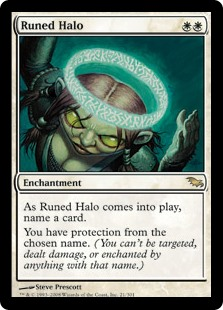 taking hits from opposing creatures while Delver clocked in the air instead of cycling Wraith to enable earlier Shadows.
taking hits from opposing creatures while Delver clocked in the air instead of cycling Wraith to enable earlier Shadows.
Death's Shadow Jund's biggest strength—its razor-sharp focus—is also its downfall. Hosers like Runed Halo, Rest in Peace, and Leyline of Sanctity turn off multiple crucial cards in the deck. Surgical Extraction can even win games against Death's Shadow Jund by exiling all copies of either Death's Shadow or Tarmogoyf, leaving the deck with only four ways to actually win. Decks looking specifically to beat Death's Shadow Jund will be able to, and usually with cards that have utility in other matchups.
Due to its lack of permission, Jund can't answer the top of its opponent's deck, making it softer in topdeck wars.
Grixis Delver: Pros and Cons
The pros of Grixis Delver are fairly obvious. It can apply early pressure and enjoy free wins with turn-one Delver, and achieves spell consistency with Serum Visions and Snapcaster Mage. Grixis also uses these blue cards to gain an edge in topdeck wars over Jund. Such benefits add up to give Grixis the upper hand in Death's Shadow mirrors.
Another supposed pro of Grixis is that it produces threats resistant to Fatal Push, but I don't think it really counts. The only reason Grixis runs Tasigur and Gurmag is that Goyf and Traverse are off-color, or we'd see Death's Shadow Jund employ delve threats as well.
One big issue with Grixis is that some of its threats require mana to set up. Tasigur, the Golden Fang and Gurmag Angler simply don't work without Thought Scour. Besides, Tasigur and Gurmag are almost always smaller than Goyf.
Grixis also lacks toolbox aspect of Traverse the Ulvenwald, meaning it has to max out on Snapcaster Mage to see the Wizard throughout the game. More Snaps means more lands. This concession makes it a far clunkier protect-the-queen deck than I'm interested in.
Finally, Grixis has trouble dealing with certain types of permanents, namely enchantments.
Bridging the Gap
Temur Shadow is built to preserve the pros and eliminate the cons of both Death's Shadow Jund and Grixis Delver. It succeeds at the cost of adopting a new con: a shakier manabase.
Temur Shadow, by Jordan Boisvert
Temur Shadow: Spells
Threats
There's little to say about the creatures in this deck that wasn't covered in the above discussion on Jund vs. Grixis. I will say that Temur Shadow has an identical creature base to Monkey Grow's (and is otherwise very close in composition), except Hooting Mandrills has been replaced with Death's Shadow.
I also want to touch on the two Snaps. Snapcaster Mage can be clunky in an 18-land deck, but having multiples for Traverse chains and late-game utility has been stellar. Snapcaster provides insurance against both grindy decks (Grixis, Abzan) and creature decks (Revolt Zoo, CoCo). I could only see going down to just one copy in metagames infested with linear combo and ramp.
Disruption
Lightning Bolt is still the best card in Modern by a huge margin, and we get to max out on it in this deck. Two  copies each of Tarfire and Fatal Push fill out Temur Shadow's removal suite, giving it 8 high-impact, one-mana kill spells.
copies each of Tarfire and Fatal Push fill out Temur Shadow's removal suite, giving it 8 high-impact, one-mana kill spells.
Thoughtseize, Mana Leak, and Stubborn Denial handle cards we can't easily one-for-one with removal. This category extends to unanswerable creatures (Wurmcoil Engine), value spells (Collected Company), and planeswalkers (i.e. Elspeth, Sun's Champion). Permission plays better with Delver of Secrets than discard, since it costs opponents tempo to spend mana on spells that don't resolve. But Thoughtseize is a must in this deck to enable Death's Shadow, and besides, it's Modern's most efficient catch-all.
Consistency
I've employed a Serum/Traverse consistency package before to some success in Temur Delver. Combined with Snapcaster Mage, these eight spells ensure we have little trouble finding exactly what we need at the right stages of the game. Consistency by redundancy is all well and good, and Modern's go-to consistency plan. But the ability to manipulate the top card of our library provides many more benefits, including helping with land drops, drawing us out of stalemates, and enabling narrow hosers in sideboarded games.
Utility
Mishra's Bauble is a necessity in this deck to help achieve delirium in linear matchups. But it also has some interesting play with Delver of Secrets, as opening both gives us two shots at flipping the Wizard on our next upkeep. Kolaghan's Command and Temur Battle Rage occupy flex spots in Temur Shadow, the former excelling in grindy scenarios and the latter shining during damage races.
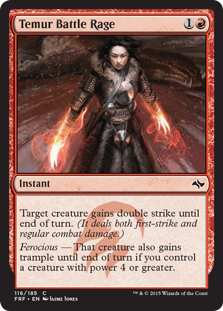 Kolaghan's Command is a mainboard answer to problematic artifacts like Chalice of the Void or Ensnaring Bridge. It also gives us a laudable grinding plan with Snapcaster Mage.
Kolaghan's Command is a mainboard answer to problematic artifacts like Chalice of the Void or Ensnaring Bridge. It also gives us a laudable grinding plan with Snapcaster Mage.
In games with Death's Shadow variants, plenty of situations arise in which Temur Battle Rage would be the best possible draw. Death's Shadow Jund packs a pair so they can have it in these situations, and Grixis runs none since they don't have Tarmogoyf and Traverse to maximize the odds of Rage being live. By the same token, Rage happens to be terrible when we don't have Goyf or Shadow on the field. Serum Visions allows us to dig for our single copy when we want it.
Temur Shadow: Mana
I actually finalized my creature and spell layout for Temur Shadow within the first day of testing, and worked tirelessly all week tweaking the mana. A convoluted manabase is the price we pay for integrating the strongest aspects of Grixis and Jund. Temur Shadow doesn't just splash; it's a bonafide four-color deck.
Like Counter-Cat, Temur Shadow aims to set up a pair of complementary shocks and chase them with a third land (usually a second blue or green source, depending on our hand). I designed this manabase bottom-up, first choosing ideal basics, then shocks, then fetchlands.
Basics
Blue and black are our most represented colors, so we play Island and Swamp as basics. Playing only one basic isn't an option in a format full of Ghost Quarter and Path to Exile. Forest doesn’t work in the main as it fails to cast too many cards. Mountain has the same issues and doesn’t help against Blood Moon.
Shocks
The deck has two shock pairs: Breeding Pool plus Blood Crypt, and Steam Vents plus Overgrown Tomb. As most of our spells are blue or black, we want those colors on separate lands, allowing us to cast more spells each turn cycle. Each shock pair achieves this goal while giving us access to all four colors.
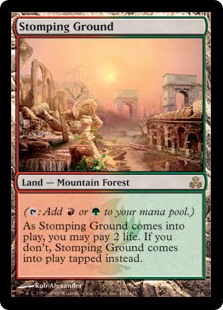 Stomping Ground enables Traverse the Ulvenwald as an early mana fixer. An opener with Traverse, a fetch, and no other lands asks us to fetch Ground and tutor either Island or Swamp depending on the cards in our hand. If we won't need red for a few turns, fetching Tomb is also an option, meaning fetch plus Traverse is guaranteed to yield three colors of our choice (so long as green is one of them). Beyond that opening play, all of our fetchlands find Overgrown Tomb, Stomping Ground, and Steam Vents, so getting our fourth color becomes as simple as drawing any fetch.
Stomping Ground enables Traverse the Ulvenwald as an early mana fixer. An opener with Traverse, a fetch, and no other lands asks us to fetch Ground and tutor either Island or Swamp depending on the cards in our hand. If we won't need red for a few turns, fetching Tomb is also an option, meaning fetch plus Traverse is guaranteed to yield three colors of our choice (so long as green is one of them). Beyond that opening play, all of our fetchlands find Overgrown Tomb, Stomping Ground, and Steam Vents, so getting our fourth color becomes as simple as drawing any fetch.
Watery Grave seems like an easy include in this deck, as it casts the most of our spells by itself and pairs with Stomping Ground. But I think the card's a trap for a few reasons. First, starting games off with Watery isn't actually good. We want blue and black on separate lands, so following Watery up with a Stomping Ground (its color pair) makes our mana awkward until we draw a third land.
Second, it's rarely a land we want to lead on and be stuck with for a couple turns. Starting on Watery seems appealing when we open a one-lander with Serum Visions, as Watery still casts Thoughtseize and Fatal Push should Visions whiff on a land. In reality, we would rather have Steam Vents in these situations. Vents casts more early interaction. Bolt and Tarfire are better at keeping us alive while we look for land drops than Thoughtseize, which doesn't impact the board, and Push, which we only play two of.
Third, since we frequently use Stomping Ground to Traverse into a basic, having Watery Grave in the deck to compliment it with is less vital, as following our basic search up with any fetch will grant us access to all four colors.
Fourth, shocks clog. Opening a non-pair, two-land combination of shocks and basics strands us on three or even two mana. Fetchlands, on the other hand, find us any color we need, either to compliment the shocks and basics we open or to set up our manabase from scratch.
Fifth, we don't have space for Watery. Running it as a 19th land would necessitate going under 26 instants and sorceries for Delver, as cutting a fetch would impact both our openers and our late-game negatively. It's true that Watery Grave is a great third land once we've set up our core shocks, but at that point, we have all our colors and have made three land drops; I doubt the marginal advantage a Watery would add compensates for the five major strikes against the card outlined above. After all, Pool or Vents (depending on the pair we have in play) are also ideal third lands.
Fetches
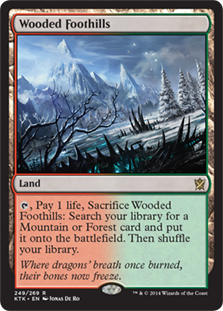 Fetchlands are critical to Temur Shadow. Sure, they synergize with Goyf, Bauble, and even Serum Visions, but that's not all. Running as many as possible gives us an edge in the early game by helping us hit the right colors, and one in the late game by making Death's Shadow that much more menacing.
Fetchlands are critical to Temur Shadow. Sure, they synergize with Goyf, Bauble, and even Serum Visions, but that's not all. Running as many as possible gives us an edge in the early game by helping us hit the right colors, and one in the late game by making Death's Shadow that much more menacing.
Serum Visions and Traverse the Ulvenwald allow us to keep one-landers, which comes up quite often in an 18-land deck. As a result, all of our fetchlands must get both Steam Vents and Stomping Ground. This requirement takes Verdant Catacombs and Polluted Delta out of the equation.
We also want all of our fetchlands drawn after a turn-one Vents or Ground to perfect our mana; as we'll have our third color from Traverse on a Stomping Ground, we're in the clear there. But since we'll need exactly Tomb on a Steam Vents, we can't run Scalding Tarn, as we risk seeing it off Serum Visions and hating ourselves.
That leaves Wooded Foothills, Misty Rainforest, and Bloodstained Mire. Foothills is our best fetch, as it gets every shock at the minimal detriment of skipping out on basics. It's our best land to open with, as it promises any color, and only ever lackluster in certain late-game scenarios that require us to fetch basics.
Misty and Mire are close, and both can set up perfect mana on their own. Two of either finds Vents-Tomb, while one of each gives us access to every shock combination. We max out on Misty because Breeding Pool is usually a more important third land than Blood Crypt. Double green represents Traverse plus Goyf, and double blue represents Serum into Delver or Snap-Leak. Similarly, we're more likely to search up Island in the late-game than we are Swamp.
A Word to the Wedge
Honestly, I could write a whole article (or two!) about this manabase. The actual spells in Temur Shadow are so powerful that the deck is quite forgiving relative to the other Delver decks I've built—no Disrupting Shoals or Simic Charms to trip over here! I therefore expect most of the losses people experience picking this deck up for the first time to come from mismanaging their fetchlands.
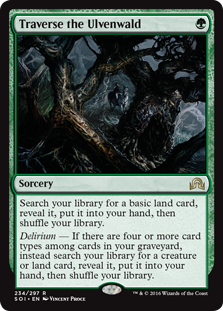 My advice to those struggling with the mana is to pay close attention to the lands they fetch and the problems they encounter, and to start planning their mana one or two turns ahead. Doing so will reveal the benefit of unintuitive available options. Stuff like burning a turn-two Traverse on Island to make a turn-four land drop, by which time we'll be able to commit a 4/4 Shadow and represent Snap-Stubborn (as opposed to allowing that extra G on turn two to go unused). Or using a valuable fetch like Wooded Foothills to get Breeding Pool instead of a less valuable one like Bloodstained Mire (since removing Pool from the deck in fact makes Mire more valuable than Foothills). Or getting Blood Crypt as a first black source with an opener full of black spells (in case we draw Misty Rainforest as our third land and need access to Overgrown Tomb). Practice makes perfect; don't get discouraged, and don't fall back on Watery Grave!
My advice to those struggling with the mana is to pay close attention to the lands they fetch and the problems they encounter, and to start planning their mana one or two turns ahead. Doing so will reveal the benefit of unintuitive available options. Stuff like burning a turn-two Traverse on Island to make a turn-four land drop, by which time we'll be able to commit a 4/4 Shadow and represent Snap-Stubborn (as opposed to allowing that extra G on turn two to go unused). Or using a valuable fetch like Wooded Foothills to get Breeding Pool instead of a less valuable one like Bloodstained Mire (since removing Pool from the deck in fact makes Mire more valuable than Foothills). Or getting Blood Crypt as a first black source with an opener full of black spells (in case we draw Misty Rainforest as our third land and need access to Overgrown Tomb). Practice makes perfect; don't get discouraged, and don't fall back on Watery Grave!
Temur Shadow: Sideboard
Sideboards change rapidly in Modern to accommodate the format's shifting climate. I might want a different 15 in a month, but here's a brief explanation of the cards I'm currently playing.
Bullets
- Traverse the Ulvenwald lets us run a creature toolbox in the side. Bedlam Reveler is our key to grindy matchups, Fulminator Mage answers annoying lands like Academy Ruins or Gavony Township, and Izzet Staticaster is Modern's most elegant solution to Lingering Souls.
Removal
- Threads of Disloyalty isn't searchable via Traverse, but it's still a mirror breaker with fringe applications elsewhere. Stealing a Goyf or Shadow is backbreaking in Modern, as these creatures have way more value than their mana cost suggests.
- Terminate is a concession to Eldrazi decks. Goyf and Shadow easily outgrow Reality Smasher, but we still don't want to lose to a hasty crackback. Also, Mana Leak isn't reliable against Bant Eldrazi thanks to Cavern of Souls.
- Destructive Revelry and Ancient Grudge answer most problematic permanents. Grudge is simply too efficient not to play in a deck that makes red and green. Revelry has added utility by doubling as a reliable anti-Blood Moon plan.
- Anger of the Gods solves our Dredge matchup, wipes away chump blockers, and dismantles creature synergy decks like Company, Merfolk, and Affinity.
- Maelstrom Pulse is a universal answer that comes in for most slower matchups. It deals with planeswalkers, swarms of tokens, and Eldrazi alike.
Utility
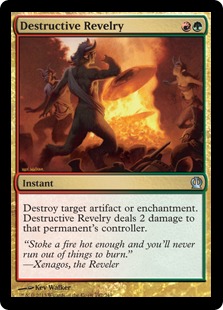 Collective Brutalityis a highly flexible card that wrecks Burn and is great in Delver mirrors. It's also easy to board in for less effective cards depending on the matchup.
Collective Brutalityis a highly flexible card that wrecks Burn and is great in Delver mirrors. It's also easy to board in for less effective cards depending on the matchup.
- Forest is good in grindy matchups, where it's an extra mana-producing land; in Ghost Quarter/Path to Exile matchups, where it generates "free" plusses; against aggressive decks that pressure our life total, where it's a green source we can fetch painlessly; and against Merfolk, where it gives us another green source to fetch as they try to Spreading Seas us off our colors. It also comes in with Destructive Revelry as a plan against Blood Moon. We then prioritize searching out the basic, knowing we have an answer for Moon in the deck should the enchantment come down (it helps that eight of our fetches find green). Having Forest on the field also lets us Traverse for our other colors under Blood Moon. I did try Forest in the mainboard at one point, but cut it for many of the same reasons as Watery Grave.
Fly over the Valley of the Shadow of Death
I've been turning Eldrazi sideways for longer than I care to remember, but Temur Shadow has me excited about grow again. The more I play with the deck, the more I believe I've finally found a Probeless Delver deck I like enough to actually use. I look forward to answering questions about the deck in the comments.


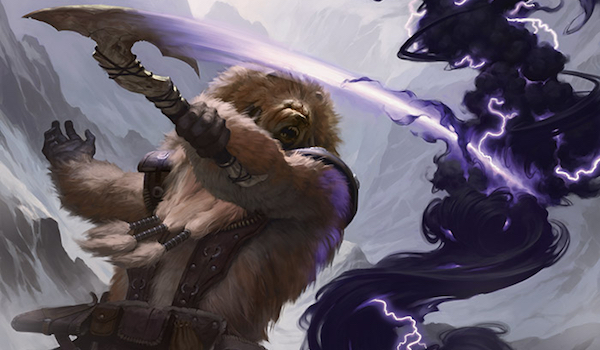



The greed is real! This deck pushes constraints to the limit and searches for the answer to the question: “Where is the line? How far can we reach our hand into the cookie jar and still come out with a fistful of grandma’s homemade macadamia nut cookies?”
I love the innovation present in this deck and I can’t wait to try and pilot it. If only probe was not banned ( :'( R.I.P ) it would be the perfect card for this deck. You can be sure I will have a bevy of questions after I get a few games under my belt. You did a good job of answering the most obvious ones, such as “Why play this over Death’s Shadow Jund?”
And at the very bottom, your “Fly over the Valley of the Shadow of Death” pun just made me shake my head and laugh. It was beautiful.
Feel free to toss those questions my way as they come up
I really hated that you ran a playset of Mandrills with a playset of Goyf, a playset of Traverse, and a couple Snappers. In my testing at least, the cards stepped on each others toes like crazy. But this new list is great man. Traverse and Goyf both want diverse card types and as long as you have more than one instant or sorcery binned, Snapper doesn’t screw them over. This is likely considering you max them out for Delver. Also gaveyard hate seemed backbreaking for the Monkey version but now that Mandrills is Shadow you have a good shot to crush them with one drops (also Delver) and ignore a RIP. Very cool deck man
Haha, yes you did. Remember we had 4 Scours though! I agree this looks better on paper, but it also feels better—mostly because Shadow doesn’t care about grave hate, as you noted. We attack from enough angles with this deck to make it very tough for opponents to hate us out with hosers like RiP, Moon, Chalice, or Anger.
I’ve been messing with this alot and really the only change I’ve tested that ended up being good was cutting the Temur Battle Rage and Kolaghan’s Command for two copies of Mutagenic Growth. It has been nice to stick a Death’s Shadow as a 1/1 or Goyf as a 1/2 without needing to leave mana up and obviously protects Abberation from Bolt as well. List is really fun m8
Yeah I can see Muta in the flex spots for Bolt-heavy metas. Glad you like it
This list looks like the best attempt to supply Death’s Shadow with a credible backup plan that I’ve seen thus far. I really feel like the deck could use a basic Forest, though squeezing it in there along with a basic Island and Swamp might prove challenging. I also feel that the sideboard is spread a little thin, but I suppose more rigorous testing of the 60 will shed some additional light on what exactly needs to be in there (I definitely don’t think it’s Bedlam Reveler, though – RR, yuck).
Addressed mainboard Forest in the mana section and I do play one in the side. Reveler usually costs 3-4 mana in this deck and definitely comes down by the time we have RR. It’s Anger I’m more dubious of on that front… I’m thinking an EE or two might be good here, too!
Yeah, EE might be the right call over Anger here. Double mana costs should be avoided if at all possible in 4c shells.
That really depends, so I wouldn’t be comfortable making a blanket statement like that. For example, Reveler is really easy to cast in this deck when you get to the stage in the game that you want to cast him in. It’s just that Anger specifically is card we really want to be casting on turn three a lot of the time. I’m going to try Kozilek’s Return next.
I was brewing myself a deck like this after testing Grixis Shadow(delverless).
It felt just like a bad version of DS Jund. Death’s Shadow is the only thing that it’s really impressive about that deck. In Jund you have the biggest,baddest Eldrazi, Tarmogoyf. And super tutor Traverse the Ulvenwald.
I have some questions regarding your build here:
1)I understand Delver diversifies your threats to a new level; but don’t you think Street Wraith is just plain better at ‘Doing the Jund thing’?. It does everyhting you want regarding deck building, fills the deck with air to compensate the 4-color mana base, and fills delirium/Goyf.
2)Do you find yourself capable of winning Tron/Eldrazi/Valakut with consistence? I know Tron and Valakut are ok, but Eldrazi seems awful(especially Bant).
I will give this deck a spin a see what it does, from what i see it has no glaring weaknesses other than the manabase.
Great article!
1) Wraith isn’t a threat (waiting until turn 5 is too unreliable). Running 8 actual beaters opens us up to stuff like Halo and Surgical, which are being employed to great effect to combat DSJ right now. Also the benefits of leading on a one-drop are huge; opponents can’t spend their turn one playing Serum or Traverse to fix their hand, lest they take a bunch of extra damage. Delver also provides free wins when opponents don’t open cheap removal, which I think is an important aspect of success in Modern.
2) Valakut/Tron has tested very favorably so far. Leak, Denial, and Seize are great here, and often just going Delver into Goyf into Shadow can beat these decks in lieu of actual disruption. Bant Eldrazi has been 50-50 for me so far, which at least is better than DSJ’s odds against the deck. If I want to shore up the MU I will consider a third Terminate in the side. Eldrazi Tron has been laughably easy to beat. We have so many answers to their Chalice plan (Leak, Denial, Seize, Grudge, Revelry, Pulse, casting Goyfs instead…) that it’s hardly even good against us.
If you think the manabase is a “glaring weakness” you should read the mana section in the article; it took me all week to perfect it, but I’m actually very happy with the manabase in this deck. Good luck!
Obivously i meant no disrespect and i read the whole article.
I tested a couple of games and mana problems came up in all of the matches. Maybe i’m fetching the wrong lands, I’m using your configuration of shocks.
When i have some more matches under my belt i will report back.
None taken. The mana is tough to learn. Let me know if you run into specific problems.
At first glance i thought “too greedy. There’s like seven lands that you might not want to draw!” Opening with basic swamp seems pretty bad, but with traverse doing double duty as a mana fixer, the deck could actually work! Look forward to hearing how it goes. Some feel that competitive sites shouldn’t showcase brews, innovation comes from experimentation, i say.
JW who feels this way? Most brew articles I see even at high-profile sites like SCG are well-received, at least judging by the comments.
would you consider surgical extraction in the sideboard for MUs like dredge, and other combo like ad nauseam or is the counter+handdisruption package alone enough to deal with those decks?
Dredge is the only combo deck we can’t easily interact with using counterspells. AN and other spell-based combo decks are very easy MUs with this deck, as are creature-based combo decks like Cheeri0s. So I don’t think Surgical is actually necessary, but it could definitely work in a flex spot depending what you want to beat. IMO Anger is a better card against Dredge specifically though.
any chance you have sideboard notes as far as what comes out in certain matchups. I am about to start messing around with this in paper and I could definitely see some number of surgicals in the board. Since the mana is already greedy, what are your thoughts on trading angers for k-returns? How has bedlam reveller been for you?
Thought about it and actually acquired some Returns today at the MM3 draft Surgical can work. I would advise people playing this deck to keep the sideboard cards they really like in Modern in their boards. There are a ton of options in this format and everyone’s unique playstyle works better with certain SB options. I have been loving Reveler.
Surgical can work. I would advise people playing this deck to keep the sideboard cards they really like in Modern in their boards. There are a ton of options in this format and everyone’s unique playstyle works better with certain SB options. I have been loving Reveler.
I wrote up a list of plans here if you want to give it a look:
http://www.mtgsalvation.com/forums/the-game/modern/developing-competitive-modern/511933-monkey-grow-rug-temur-delver?comment=3635
This deck seems great! I’m going to do some testing with it for sure. I especially enjoyed the section about building the manabase as that is something I often struggle with, and one reason I prefer to tune other peoples decks rather than building my own :/ . 2 questions: First, could there be any space for whispers of emrakul in the 75? The card seems great in a heavy discard deck if you could reliably get delirium by turn three. Second, I don’t know that collective brutality is good against other delver decks. The delver decks I know about play many counterspells that are just waiting to two for one you, and the card just seems too clunky when you’re only using one mode (does seem great against burn though.) Thanks for the awesome content!
1. We don’t even want the effect, let alone on a card so inefficient. 2 mana is a whole lot. This is not a “heavy discard deck.” We want all our cards to impact the board if possible, making exceptions for cantrips (which cost 1 and keep our engine greased) and Thoughtseize (the most versatile, efficient discard spell ever printed, and a must with DS in a Wraith-less deck). We are also not rushing into delirium with this deck.
2. Brutality has been insane for me Delver mirrors. Taking Delver and a removal spell/counterspell/value card like K Command for two mana is awesome, especially when the second card you trade is a spare fetch or something. It’s also just sweet in a lot of other matchups. This card is killer!
just gave it a whilr for 2 matchups. In every single game I wished there was a watery grave. small sample size and you did say the manabase is the hardest thing to figure out but that’s my initial reaction. Loved the hands I had to work with, as I have always loved sultai/temur delver where you go delver-goyf then sit with denial/snap in hand. As jund players discovered, adding deaths shadow as a one mana finisher is also good.
I did drop kcommand for a mutagenic – seems way better for shadows and saving flipped delvers from bolt.
Practice practice practice and you learn to love no Grave. Like I said in the article, it’s a crutch. You will only want it until you understand how the mana works. Don’t mean to sound condescending but I think it really comes down to reps. The guys I shopped the mana with felt the same way about Grave for a few days before all coming around. Omitting Grave was the probably most unintuitive thing about crafting the manabase.
I would definitely not play more than one Muta right now by the way. Its applications are just too narrow. But I can see having one as a gotcha!
Great deck skeleton Jordan! I’ve been waiting to see if this shell was viable since Gerry Thompson put up his Grixis shadow list. Noting your points about delver, I’d still argue that you’re better off running four Street Wraith and four Bauble over tarfire to turn on traverse. Twelve threats is a fine amount for a 52 card deck, and you ennui with room for more individually better spells.
Re: the mana base, I really appreciate the work you put in to develop it. There’s a lot of thought and intention here. The only land I quibble over is steam vents, cf watery grave, but I also don’t run tarfire in this shell. Re: your spell suite, I think your mana leaks would be better off as more stubborn denials, or abrupt decays. Chalice and blood moon destroy this deck, and having an out that you can float mana over the moon etb to save your mana seem crucial. I note your maelstrom pulse and revelries post board for situations like this, but I’d still argue the card maindeck
You’re maybe right. Part of what inspired me to build this deck (and one of the strengths of Grixis relative to DSJ) was that I didn’t like how few threats were in DSJ. Halo and Surgical become against that deck because the actual threat count is so low.
I agree that Denial is a better counterspell against the meta in general. But this is Modern, and we’re likely to run into some random stuff over 9 rounds. Leak is an all-purpose answer for the weird stuff people like to play. Stormbreath, Sigarda, Rallier, Primeval Titan, Finks, etc. are all Modern-played cards and each can hassle us if we don’t have an out.
Leak is also great to hold when we’re ahead since it makes it very difficult for opponents to outplay us. They can’t play a creature expecting Denial or play a removal spell expecting Push; whatever they do we can say no to. In a deck with Delvers, we’re likelier to be ahead on the board.
Care to defend Watery over Vents with some arguments? Would love to hear!
Ultimately no, I agree with you that watery grave is the worst shock we have available to us if we’re trying to fully 4c, though only because it can’t traverse a basic if we don’t open a fetch. As you’ve said, getting that fixing off Traverse saves a lot of hands, so every green shock gets priority over other colors. Given the amount of red in your deck, the vents as the third red source is definitely necessary.
I’ve definitely seen that your mana base makes the 4c deck I’ve been working with a lot better. I came at it more from the Sultai splash red angle.
Creatures:
4 Death’s Shadow
4 Tarmogoyf
4 Street Wraith
3 Snapcaster Mage
Instants:
3 Lightning Bolt
2 Fatal Push
2 Stubborn Denial
2 Abrupt Decay
1 Temur Battle Rage
1 Kolaghan’s Command
Sorceries:
4 Traverse the Ulvenwald
4 Thoughtseize
3 Serum Visions
Artifacts:
4 Mishra’s Bauble
Lands:
Your mana + basic forest
This is what I see porting Legacy Canadian Thresh into the DS shell looks like, because I find the decks remarkably similar. Like Thresh, we play the best 1 and 2 mana cards in colors and we mimic the consistency of Ponder / Brainstorm by thinning the deck to 45 cards (8 free cycles and 7 cantrips). Given how thin the deck is I’ve been considering cutting the basic Forest entirely, moving me back to your 18 land count, but I think I’d rather the extra land than the 4th Visions, especially one that traverses my opening 7 into playable territory.
SB is as you’ve noted, entirely customizable, but I think any deck not playing Delver would want to see if we have any other toolbox creatures to run as virtual 5 ofs, Kira comes to mind.
Hey, I tried the list and must say it really isn’t good. You are trying to mash rug delver with Death Shadow Jund, but sacrificing a lot of consistency.
Death Shadow has 4x Bauble & 4x Street wraith. Delver has around 10 Cantrips. In your list you are only running 4 serum visions, which is way to few cantrips.
Also this version is way slower than Death’s Shadow Jund, you can’t reliably beat tron or eldrazi with this list.
Don’t understand me wrong I like the idea and sound of the deck, but speaking competitive this ain’t gonna cut it.
PS: The mana was really good. Never had a problem. Still felt like Traverse was way too clunky in this deck. You don’t have delirium as early as u’d like, and the only tragets meanwhile have been Island and Swamp.
I would rather cut 2x Traverse and maybe add 2 more bubbles
Any chance you have video content of your online testing?
I don’t record unfortunately. May look into it in the future, or if I ever splurge and get a PC for MODO! (PCs are just way overpriced!)
It’s been half a week since publication and I’ve made the following changes.
Main:
-1 Kolaghan’s Command
+1 Mishra’s Bauble
SB:
-1 Destructive Revelry
-2 Anger of the Gods
+1 Kozilek’s Return
+1 Engineered Explosives
+1 Temur Battle Rage
Added a Bauble to help hit delirium in linear matchups, although a better plan here may be to just side out Traverses. Also considering Spell Snare and TBR #2 in this slot for that reason. Drawing two Baubles is really, really bad. KC was frequently clunky and we’re OK at grinding anyway.
Anger was too hard to cast so I split it into Return and Explosives. Also cut a DR for a TBR in the side and I like having two as a concrete plan. TBR comes in against the following decks:
– Decks that chump as a plan (Spirit tokens, dorks, walls, etc.)
– Decks that are way faster than us (Affinity, Tron, etc.)
– Decks that struggle to remove Shadow (Merfolk, Temur/UR/RG/UG decks, linear combo/aggro)
Threads might be too cute and I’m considering cutting it for a second EE (amazing card) or a third Brutality (super flexible; superb against Burn). It’s great vs Shadows and Goyfs but sometimes dead, forces us to fetch double blue early on which can be annoying, and super lackluster against other creatures. Threads on a Lord does remove it, but we have no use for a 2/2, for example.
i had to stop reading at “lightning bolt is the best card in modern by a huge margin”. i just can’t take you seriously after that. i mean, its a good card, but not nearly the best.